Alpaca
Vicugna pacos
They can spit up to 10 feet.
Advertisement
Alpaca Scientific Classification
- Kingdom
- Animalia
- Phylum
- Chordata
- Class
- Mammalia
- Order
- Artiodactyla
- Family
- Camelidae
- Genus
- Vicugna
- Scientific Name
- Vicugna pacos
Read our Complete Guide to Classification of Animals.
Alpaca Conservation Status
Alpaca Facts
- Name Of Young
- Cria
- Group Behavior
- Herd
- Fun Fact
- They can spit up to 10 feet.
- Estimated Population Size
- Least concern
- Biggest Threat
- Loss of rangeland
- Most Distinctive Feature
- Hypoallergenic fleece
- Other Name(s)
- Vicugna
- Gestation Period
- 242-345 days
- Litter Size
- One
- Habitat
- Farms, temperate high meadow
- Diet
- Herbivore
- Favorite Food
- Hay, pasture grass and/or silage
- Common Name
- Alpaca
- Number Of Species
- 1
- Location
- Andes Mountains of Peru, Bolivia, Ecuador and Chile
Alpaca Physical Characteristics
- Color
- Brown
- Fawn
- Black
- White
- Tan
- Dark Brown
- Cream
- Chocolate
- Caramel
- Beige
- Chestnut
- White-Brown
- Black-Brown
- Sandy
- Golden
- Blonde
- Light-Brown
- Skin Type
- Fur
- Top Speed
- 35 mph
- Lifespan
- 15-20 years
- Weight
- 48-84 kilograms (106-185 pounds)
- Height
- 81-99 centimeters (32-39 inches) to withers
- Length
- 120-225 centimeters (4-7 feet)
- Age of Sexual Maturity
- Females 18 months; males two to three years
- Age of Weaning
- Around six months
View all of the Alpaca images!

The alpaca is a camelid mammal native to South America.
Closely related to its larger cousin, the llama, the two species are able to interbreed. Yarn spun from alpaca wool is popular for warm, soft sweaters, socks, mittens, and hats, making the fur of these domesticated animals a valuable commodity.
Five Incredible Alpaca Facts!
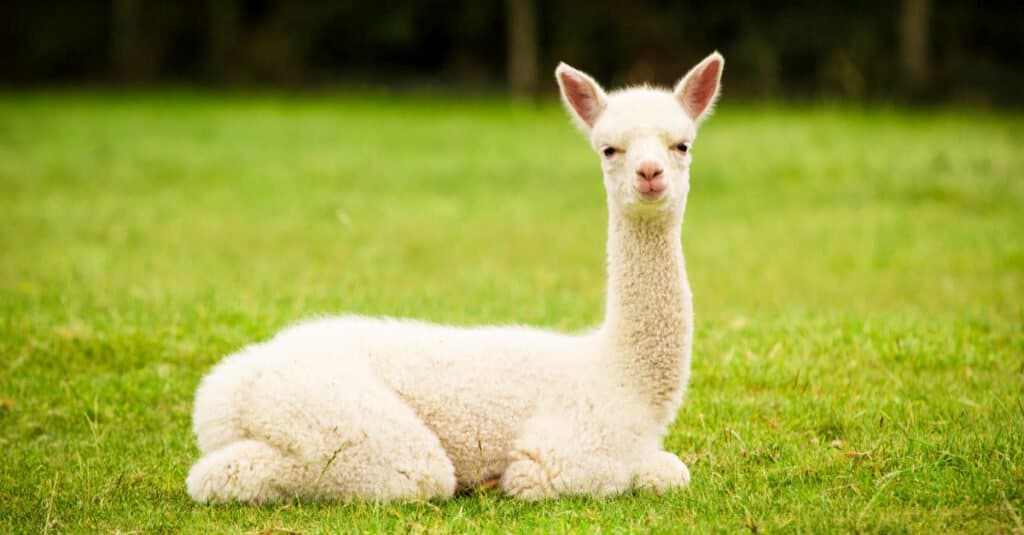
Alpacas’ stomachs have three chambers.
©murbansky/Shutterstock.com
- The ancient Incas first domesticated the alpaca more than 6,000 years ago. They made robes of alpaca fur for the nobles and royalty.
- Alpacas’ stomachs have three chambers.
- The single alpaca species has two breeds: the dreadlocked Suri and the fluffy huacaya.
- Most of the noise alpacas make is humming. Depending on the situation, this expresses contentment, curiosity, boredom, caution, or distress.
- When llamas cross-breed with alpacas, the baby is called a huarizo.
You can check out more incredible facts about alpacas.
Scientific Name
The scientific name for alpaca, Vicuña pacos, reflects its descendency from the vicugna, an ancient, wild camelid mammal. Prior to 2001, these animals were called Lama pacos.
However, a DNA study revealed it descended from the vicugna rather than the guanaco, the llama’s forbear. This fact generated the name change.
Huacay is the most prevalent breed of alpaca in Australia and South America. Australia has fewer Suri alpacas than other countries. Farming Alpacas have been around since 1989. They have existed in Australia, where there is a small but close-knit alpaca farming community.
Evolution and Origins
Alpacas’ ancestors originated in North America. They changed into the modern camel during their migration to the north across the Bering Bridge. Alpaca, llama, vicuna, and guanaco are South American Camelids, which are a result of migration to the south.
Alpacas are South American natives that were developed from the now-rare and protected Vicuna wild breed. The wild Guanaco, which is still very abundant throughout South America, is the ancestor of the llama. Both of them are members of the camelid family, which includes Asian camels.
Alpacas are thought to have originated around 6000 years ago through breeding largely influenced by the vicuna. The alpaca and the wild vicuna are very similar in terms of size, fiber, and dentition.
Appearance
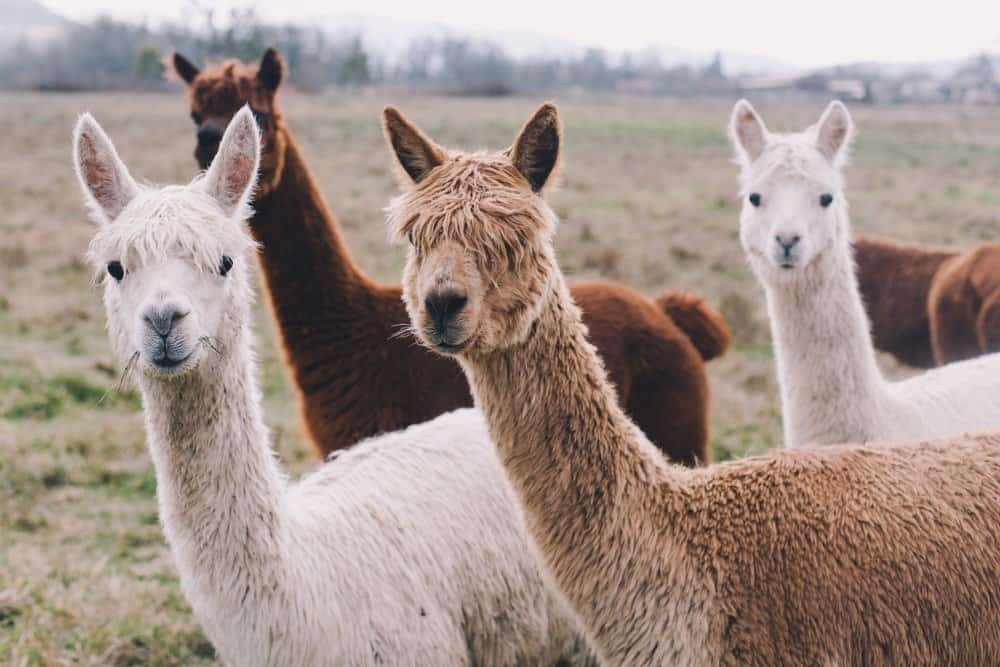
Colorful group/pack of Alpacas
©Canna Obscura/Shutterstock.com
The alpaca is a smaller animal than the llama, although the two resemble one another in several ways. These animals stand 32-39 inches from foot to wither, and they measure an average of 5.5 feet in length. They have small heads, large eyes, flame-shaped ears that stand up, and long necks.
The two breeds have different types of fur. The huacaya breed, which comprises about 90 percent of the world’s alpacas, has thick, fluffy fleece adapted for life at cool, high altitudes. The suri breed has silkier fur that grows into long dreadlock-type curls.
Experts believe their silkier, less dense wool is the product of life in a lower, more temperate mountain environment. Right after shearing, alpacas look more like humpless camels than llamas.
Alpaca Vs. Llama
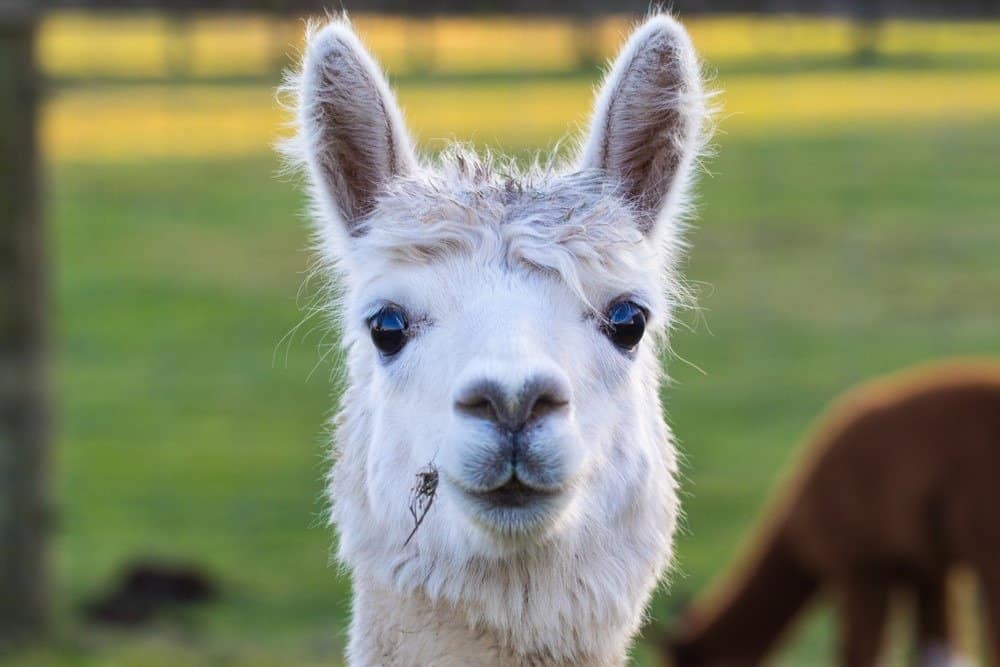
Cute Alpaca on the farm
©1Roman Makedonsky/Shutterstock.com
Some similarities and differences in appearance between alpacas and llamas include:
- Ears: Alpacas’ ears are short and flame-shaped while llamas’ are longer and banana-shaped.
- Head: The alpaca’s head is shorter and blunter than a llama’s head.
- Weight: Alpacas average around 150 pounds while llamas are more than twice that weight.
- Height: Llamas are about 10 inches taller at the withers than alpacas.
- DNA: Llamas are descended from the guanaco while alpacas are descended from the vicugna, both wild camelid mammals.
- Use: Alpacas are animals that are prized for their soft, warm, and fire-resistant wool while llamas are mainly employed as pack animals and guards for domestic herds such as sheep.
- Disposition: Alpacas are timider than llamas.
Behavior

Cute white Alpaca with lots of wool on a lush green grass background
©Thomas Devenish/Shutterstock.com
Overall, this small camelid mammal is intelligent, gentle, and friendly. It lives in herds and is very sociable with other alpacas. Within each herd, family groups each consist of several females and their young plus an alpha male. Like other ruminants such as horses, they can be flighty and nervous when they sense a threat is nearby. Males can get aggressive and sometimes fight other alpaca males.
These animals communicate through body language and the sounds they make. Sometimes a male will stand broadside before his family with his ears all the way back. This is a protective pose. To a baby, a larger object or animal means protection, and the baby will follow or sit near it.
These animals hum when they are happy, bored, curious, worried, or distressed. A mother and baby may hum together when bonding. A mother may cluck, henlike, when worried about her cria. A male might cluck in welcome to others.
When it feels threatened, like when a strange alpaca is crowding its space, this animal snorts. It may also make a gurgling sound to warn others.
This animal can make loud sounds of distress too. When mishandled or physically threatened, it can voice an ear-splitting scream. Males screech to intimidate other males when fighting for dominance. Females screech when upset, but it sounds more like a growl.
Habitat
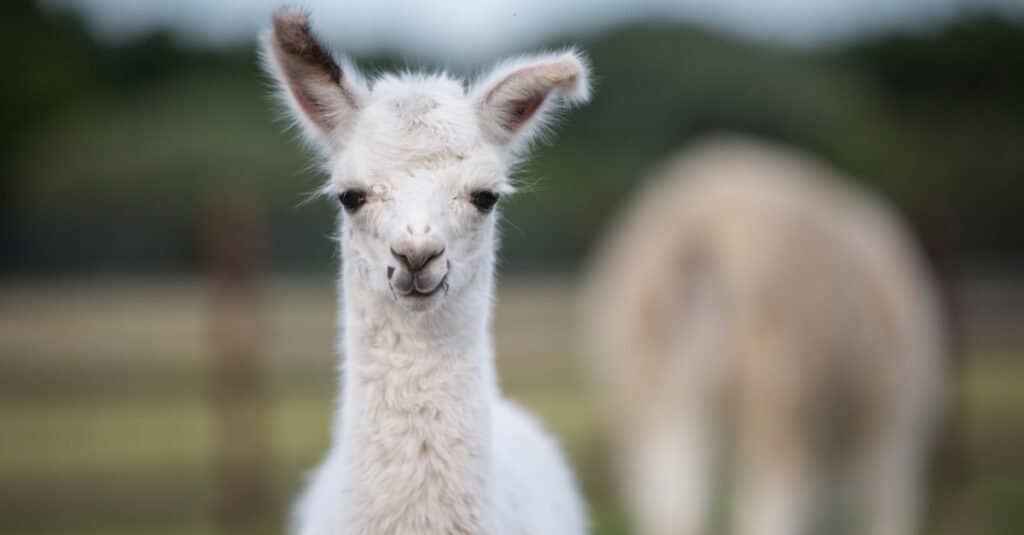
Three young alpacas all different colors
©Inesmeierfotografie/Shutterstock.com
Since the era of the Incas, these animals lived in domesticated herds in the Andes Mountain highlands. They live there still, sharing a habitat with other South American mountain natives like spectacled bears, mountain lions, condors, flamingos, and llamas.
These animals also adapt well to other environments. They live throughout the world on alpaca farms where farm workers harvest their wool for yarn and garment manufacturing.
Diet
These animals are grazing animals. They eat fresh grass in the field, hay, and occasionally, bark or tree leaves. Farmers sometimes supplement the hay with nutritional additives designed for special situations, such as pregnancy and lactation.
They are “easy keepers” because they don’t eat a lot. A 125-lb. animal only needs about two pounds of hay, or 1.5 percent of its weight, per day. The grass is difficult to digest because of its fibrous nature. Alpacas have stomachs with three chambers to do the job efficiently. This camelid mammal’s stomach also secretes acids that aid in digesting rougher forage so they can get the nutrients they need.
Predators and Threats
Larger carnivores who live in the same South American highlands prey on these animals. These include bears, maned wolves, and coyotes. Although they have few defenses against such predators, they do have long necks that allow them to see danger approaching.
In other locations, these animals are under threat from native wildlife, which may be gray wolves, packs of domestic dogs, and foxes. They can vocalize and spit to frighten off predators.
Reproduction and Life Cycle
Females do not have a specific breeding season. Instead, whenever they breed, it induces the reproduction process. Typically, they breed once per year because it takes up to 345 days for a baby to develop in the womb.
These animals have a single baby at a time. The average newborn weighs 8 to 9 kg (19 lbs). At around 7 months old, the mother weans the cria. Female juveniles will be ready to mate at 12 to 15 months. Males reach sexual maturity quite a bit later, at around three years of age.
Healthy animals can live as long as 20 years. One extraordinary alpaca lived to be 27.
Population
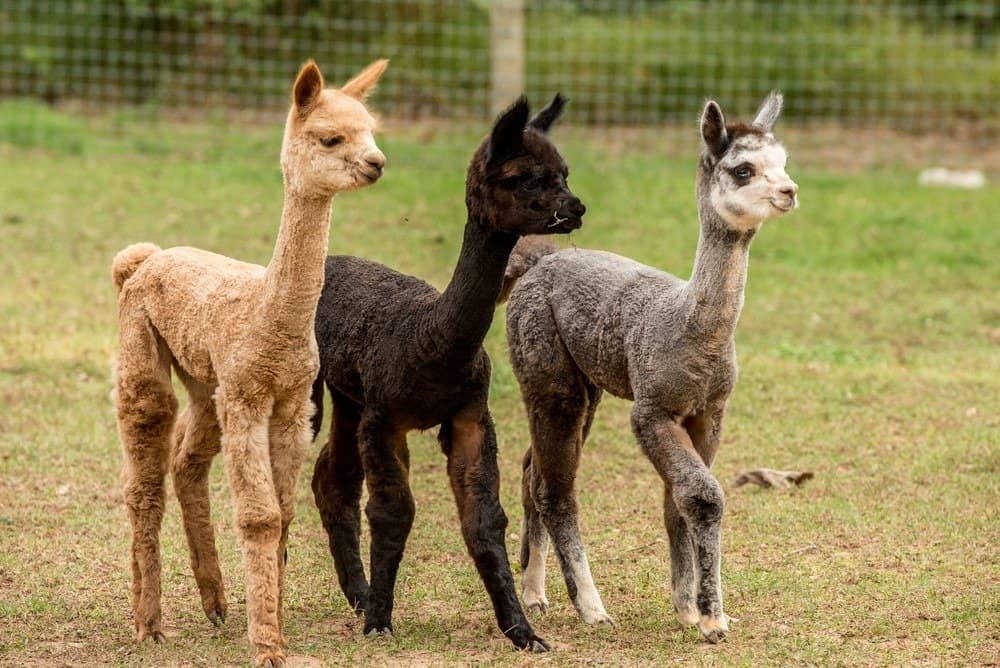
Three young alpacas all different colors
©Karyl Miller/Shutterstock.com
The largest population of these animals worldwide lives in the Andes Mountains of Peru. It accounts for more than 50 percent of all of them.
At one point in the 16th century, the species almost disappeared. Disease brought to South America by the Spanish invaders nearly decimated the population, killing 98 percent. Also, due to the conquest, the remaining animals had to move to higher ground, where they still live today.
During the 19th century, European settlers rediscovered the species and found the animal to be of value. They prized the animals for their wool and nurtured them. Thereafter, the remaining population began to recover and eventually once again become robust. Today, alpacas are not listed on the IUCN Red List of Threatened Species.
View all 194 animals that start with AAlpaca FAQs (Frequently Asked Questions)
What is the difference between an alpaca and a llama?
Alpacas and llamas are both native to the Andes mountains of South America. They are different, though, in several ways. Alpacas are smaller, their heads are shorter, and their ears are smaller than those of llamas. Alpacas have shaggy fur that, when spun into yarn, is silky, warm, and fire-resistant. Llamas have coarser fur. In addition, alpacas are timider than llamas. Llamas make better guard animals.
Are alpacas friendly?
Alpacas are friendly, social animals who prefer to live in herds. They are typically tame enough for petting, but they do not make very good pets, due to their need to be with others of their kind.
Are alpacas dangerous?
Alpacas are not very dangerous unless they feel threatened. Their main defenses against predators are spitting and vocalizing. Occasionally they will bite in self-defense, but they rarely bite humans.
Why do alpacas spit?
Spitting is a defense mechanism and also a way to ward off unwanted attention. For example, a female might spit if she wants to discourage a male’s attention. A male might spit at another male to express dominance. Sometimes alpacas spit to warn others away who are encroaching on their food source.
Do alpacas smell?
Practically every mammal has a distinctive scent, although not all of them are detectable to humans. Alpacas, which are tidy animals, do not have a strong or unpleasant scent, but they do smell like alpacas. Because they limit their bathroom area to a single spot, it can develop an unpleasant odor if it builds up.
Do alpacas bite?
Alpacas are not normally aggressive, and they do not bite unless they feel immediately threatened. Although they are grass-eaters, they still have sharp canines in the front of their mouths, so you should approach alpacas carefully.
Are Alpacas herbivores, carnivores, or omnivores?
Alpacas are Herbivores, meaning they eat plants.
What Kingdom do Alpacas belong to?
Alpacas belong to the Kingdom Animalia.
How fast is an Alpaca?
An Alpaca can travel at speeds of up to 35 miles per hour.
Thank you for reading! Have some feedback for us? Contact the AZ Animals editorial team.
Sources
- Wikipedia / Accessed November 25, 2020
- Live Science / Accessed November 25, 2020
- Britannica / Accessed November 25, 2020
- Bioweb / Accessed November 25, 2020
- Alpalca Owners Association / Accessed November 25, 2020
- Blue Planer Biomes / Accessed November 25, 2020
- Successful Farming / Accessed November 25, 2020


















